If you want to take up camping and you want a lot of space, you’ll want to figure out the best cabin tent for you.
Cabin tents feel like a home-away-from-home, thanks to their straight walls. You can comfortably walk around in a cabin tent, and they’re usually spacious and nice to hang out in.
But with so many to choose from, how can you figure out which one is best?
We’ll tell you straight away that we really like the Eureka! Copper Canyon 4-Person Tent. Keep reading to find out more about it.
We also like:
- ALPS Mountaineering Camp Creek 4-Person Tent – Best for a smaller budget
- HIKERGARDEN 6-Person Tent – Best for quick and easy set up
We’ll be looking at:
- The best cabin tents, compared
- What to look for in a cabin tent
- 6 of our favorite cabin tents, including their specs, pros and cons
- Frequently asked questions
- Which one we like the best and why we love it so much
Let’s get started!
Table of Contents
- Best Cabin Tents Compared
- What are Cabin Tents?
- What to Look for in a Cabin Tent
- Top 6 Best Cabin Tents
- Frequently Asked Questions
- Final Thoughts – Which Cabin Tent is Best?
Best Cabin Tents Compared


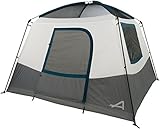









What are Cabin Tents?
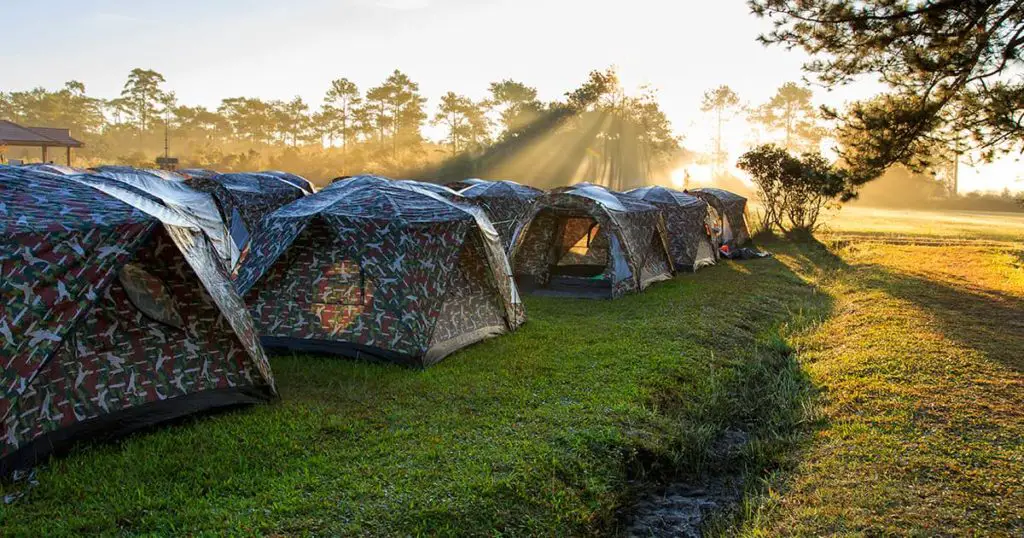
A cabin tent is normally larger than a typical dome-style tent, in that they are usually taller, allowing you to stand up easily inside. The extra space makes them perfect for camping with larger groups.
What to Look for in a Cabin Tent
Let’s take a look at what you should be looking for in a cabin tent.
Size and Layout
Cabin tents are designed to be roomy. Unlike dome tents, which have sloping walls and are, well, dome-shaped, cabin tents have straight walls. This makes them ideal for taller people (for more on that, check out our guide to the Best Tall 4-Person Tents). It also means that you should be able to walk around comfortably without hitting your head on the ceiling.
Cabin tents give that real ‘home-away-from-home’ feeling, as they feel spacious.
Different tents have different layouts. For example, your cabin tent may have two bedrooms, which will allow you more privacy if you’re camping in a larger group. You may also have a ‘living area’, or an enclosed porch area. This will enable you to hang out in your tent without your beds or sleeping pads getting in the way.
It’s always worth checking to see the actual dimensions of your tent. Although your tent may say it sleeps 5, for instance, it may actually be a bit of a tight squeeze at max capacity.
Finally, there’s gear storage to consider. Where will you keep your backpacks and rain jackets? Gear lofts are ideal for storing these things out of the way when they’re not in use, but not all tents have them.
What about your valuables like your cell phone or keys? What about your water bottles? These can be kept in smaller pockets, typically sewn into the inner lining. This is ideal for keeping track of your essential items.
Materials
Tents are usually made from one of the following materials:
- PVC (Poly Vinyl Chloride) – normally used for cheaper tents (like those in our guide to the best tents under $200), these tend to be made from cotton, and then coated with waterproof substances like acrylic or polyurethane. It’s cheap, but not that breathable, which means you might have some condensation problems.
- Polyester – lightweight and durable, this is a popular material for tents. They tend to be coated in the same way as PVC.
- Nylon – this is cheaper, but thinner, and more prone to UV damage. It also tends to be coated in the same way as PVC and polyester.
- Polycotton Canvas – this is a polyester/cotton mixture, also coated for extra water protection.
- Cotton – cotton tents have to be ‘weathered’ before you use them. This involves allowing them to sit in rain, as the fibres swell and draw close together, preventing leaks. Cotton tents are harder to find now, as most companies tend to focus on polyester or nylon tents instead.
Tent poles are what create the frame, and they tend to be made of aluminum or fiberglass. Aluminum is cheaper, but fiberglass tends to be more durable.
Seasons
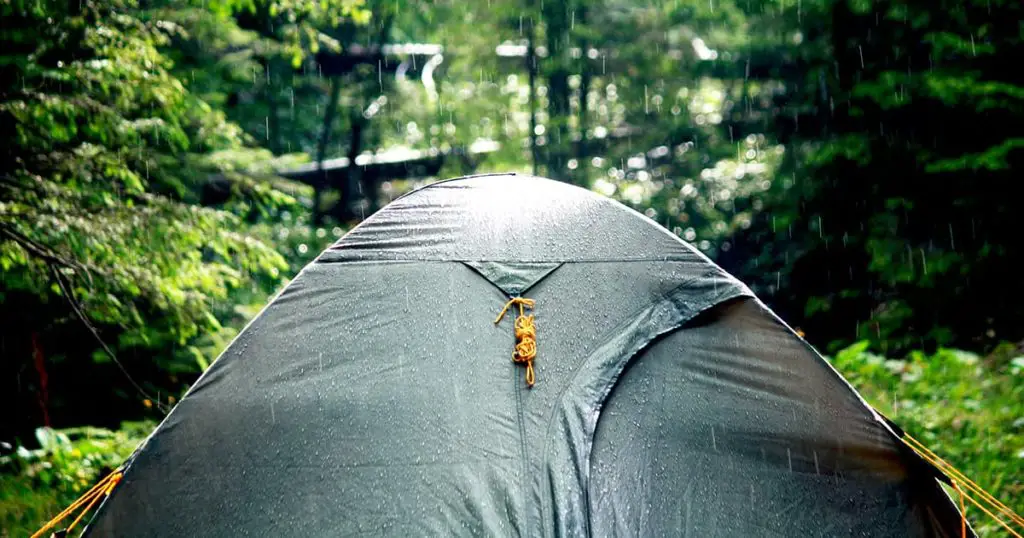
Tents are advertised as being good for different seasons. Here’s a quick rundown:
- 1 Season – these are super-lightweight, thin tents ideal for camping in the summer. They won’t keep the rain out.
- 2 Seasons – these are a little more waterproof than a 1-season tent, but still won’t withstand a downpour. They work well if you’re camping in warm weather.
- 3 Seasons – the most versatile, these are great for camping in changeable weather, as they usually have good ventilation for warmer days as well as waterproofing for wet weather. (Check out our guide to the Best Family Tents for Bad Weather – this features a lot of great 3-season tents.)
- 4 and 5 Seasons – more rarely found, these are more specialist tents designed for camping in snowy and icy conditions.
You can check out our 3-Season vs 4-Season Tent comparison to see which works better for you.
Weatherproofing
Weatherproofing is a big deal when it comes to camping! It’s reassuring to know you’ll be covered in most weather conditions.
Some tents advertise their hydrostatic head measurement. This is measured in millimetres (mm). The number represents the depth of the water that will be able to pool on top of the tent before it starts to seep through. The deeper that pool of water, the more rainproof your tent will be. 2,000mm is a pretty decent measurement.
However, not all tents advertise this. You can look for other clues – are your seams heat-sealed? This can prevent leaks from coming in at the sides. Covered zippers also help to keep leaks at bay.
Most tents come with a rainfly (a cover which protects the inner tent – these can sometimes be removed, revealing mesh walls inside. This is ideal for stargazing in warmer weather without being bitten by insects).
They may also come with a footprint (waterproof material that goes underneath your tent). Not all tents have a footprint though, so it’s worth checking beforehand. Footprints can be bought separately (this is a good example), or you can just use a tarp cut down to the right size.
Ease of Setup
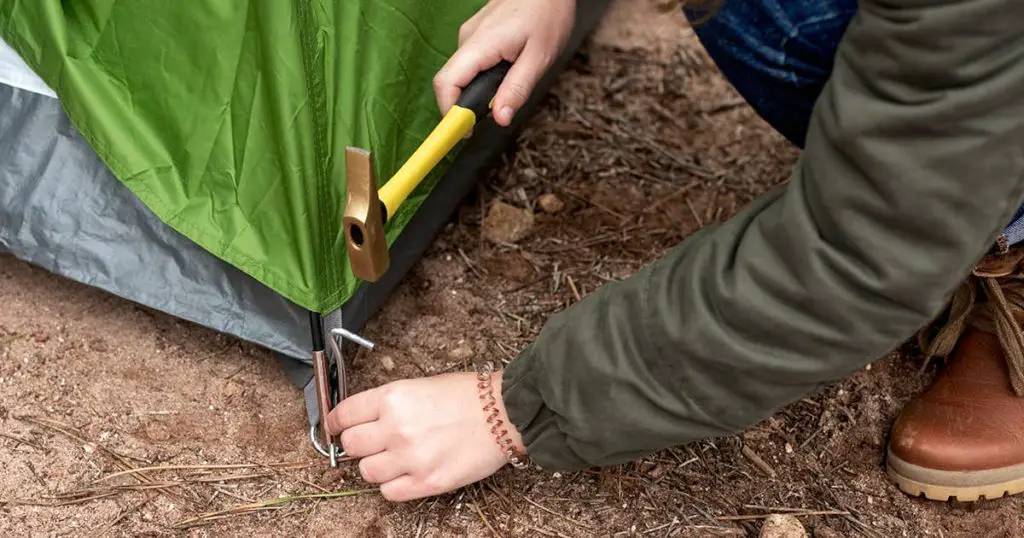
It can feel daunting to set up a cabin tent, as they’re so large and involve a lot of poles and fabric! However, it doesn’t have to be complicated. Some tents are easier than others to set up. Color-coded poles and clear instructions are really helpful here, and some tent manufacturers offer instructional videos.
It’s always worth putting up your tent at least once before you go though, just in case you run into any problems.
Portability
Finally, you’ll want to consider portability. Most tents pack down into a pretty small bag, but it’s worth checking to see if it’s small enough for you (especially if you’re backpacking – check out our guide to the best backpacking tents under $100 for more suggestions).
Weight can be an issue too, as some cabin tents can be on the heavier side. If you’re backpacking, you can make it easier by splitting the poles and the material between you, so one person doesn’t have to carry the whole load.
Top 6 Best Cabin Tents
Now that we’ve covered what you should look for – let’s look at 6 of our favorite cabin tents in more detail!
Eureka! Copper Canyon 4-Person Tent – Best for Tall Campers

Key Features
- Sleeps: 4
- Size:
8 x 8 x 7 (ft)
96 x 96 x 84 (in)
244 x 244 x 213 (cm) - Size packed:
9 x 27 (in)
22.86 x 68.58 (cm) - Weight: 17.3lbs/7.84kg
- Materials: UV-resistant nylon/polyester
- Seasons: 3
The Eureka! Copper Canyon 4-Person Tent is great for taller people. The straight walls come in at 7ft tall (84in / 213cm). Even if you’re not particularly tall, you’ll enjoy the spacious feeling that this tent will give you. It’s a one-room tent designed for 4 people, but there’s plenty of room for gear – it has overhead storage and a small pocket. Plus, it has a zippered e-port, which allows you to feed an electric cable into your tent without worrying about leaks.
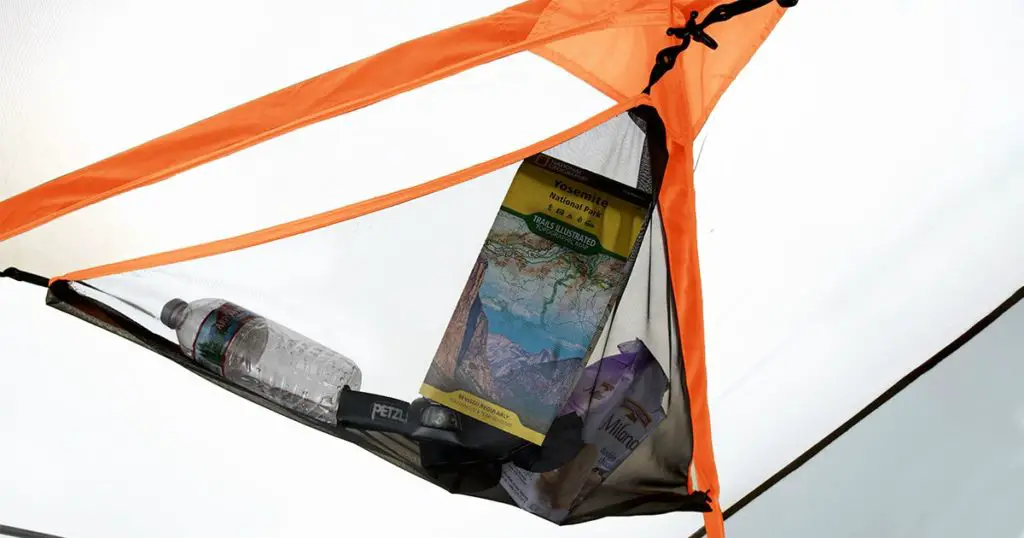
Weather-proofing wise, it has an extended rainfly, which helps to keep rain out of the entryway. It also has large mesh windows for ventilation, which is great for keeping you cool in warmer weather.
The downside is that it’s a bit more difficult to set up than you might like if you’re a newbie to camping. Experienced campers can manage it in around ten minutes with two people, but newer campers found it took longer. It’s definitely worth practicing before you head out.
It folds down into a fairly small bag, and it’s not excessively heavy either.
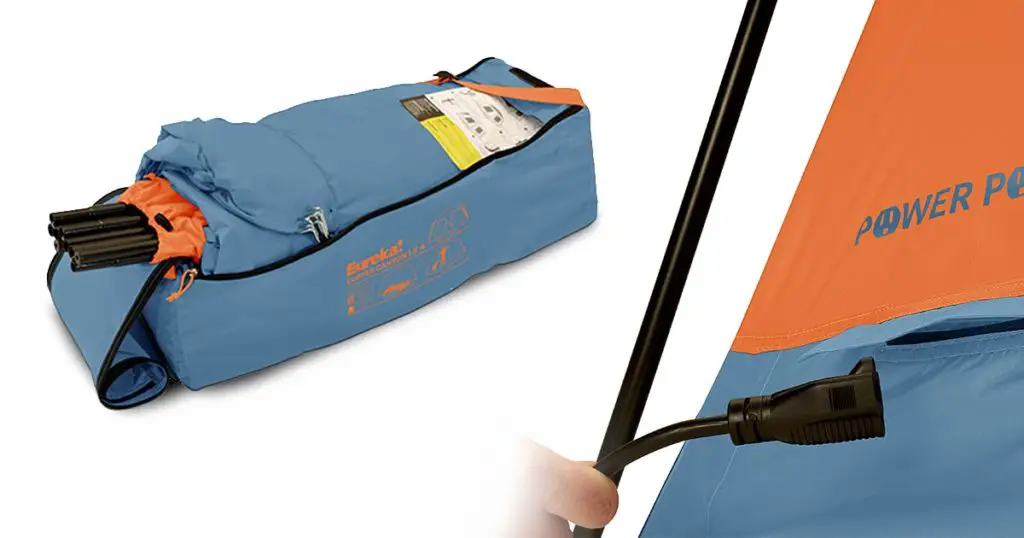
Pros
- Great for taller campers
- Good ventilation and weatherproofing
- Lots of storage
- Easily portable
Cons
- May be difficult to set up for beginners
Coleman Cabin Camping Tent with Screen Room – Best Spacious Cabin Tent

Key Features
- Sleeps: 6
- Size:
13 x 10 x 6ft 4in (ft)
156 x 120 x 76.8 (in)
396 x 305 x 195 (cm) - Size Packed:
26 x 12 (in)
66 x 30 (cm) - Weight: 22lbs / 9.86kgs
- Materials: Coated polyester
- Seasons: 3
The Coleman Cabin Camping Tent with Screen Room is a 6-person tent. It has a large main room for lounging in, with an enclosed porch area. If you want to sit and chat whilst looking out at the stars at night, it works really well. You can also store your gear there too.
It has a tub-style floor, with welded seams. The seams curve upwards at the edges, which is designed to keep the ground dry. It has a removable rainfly, which is ideal for warmer weather, as it improves ventilation.
As it’s a pretty big tent, it does take a bit longer to put together – it takes around 25-30 minutes. While it’s not complicated, it is a bit more time consuming than some of the others we’re looking at today. It’s also on the heavier side, which is something to bear in mind too.
Pros
- It includes a screen room for hanging out in and storing gear
- It has good waterproofing
- The ventilation is good if you remove the rainfly
Cons
- It’s on the heavy side
- It takes a while to assemble
- Not easily portable
ALPS Mountaineering Camp Creek 4-Person Tent – Best Budget Option

Key Features
- Sleeps: 4
- Size: 7.6 x 8.6 x 7 (ft)
91.2 x 103 x 84 (in)
232 x 262 x 213 (cm) - Size packed
8 x 28 (in)
20 x 71 (cm) - Weight: 91.kg/20lb
- Materials: Polyester with 1500mm coating
- Seasons: 3
The ALPS Mountaineering Camp Creek 4-Person Tent is a good lower-priced tent, with lots of space for the cost. At 7ft tall (84in / 213cm), it feels spacious. It has one room, but it also has a three-pocket mesh storage area, perfect for storing smaller items.
It’s got decent rain protection, but some users reported a bit of leaking in heavy downpours. It has large mesh windows, which is good for warmer weather. The door can be completely unrolled on warmer days. In fact, we’d recommend it as a good tent for warmer climates.
The downside is this one isn’t that easy to assemble for beginners. It took some users a few attempts to get it right, so it’s another one that’s worth practicing with first.
Pros
- Good for warmer weather
- Lots of headroom
- Storage area included
- Good price
- Easily portable
Cons
- Won’t withstand very heavy downpours
- May be difficult to set up for beginners
HIKERGARDEN 6-Person Tent – Best for Fast Setup

Key Features
- Sleeps: 6
- Size:
10 x 8 x 6ft 3in (ft)
120 x 96 x 76 (in)
305 x 244 x 193 (cm) - Size Packed:
24 x 8.7 (in)
61 x 23 (cm) - Weight: 23lbs / 10.43kg
- Materials: Polyester
- Seasons: 3
The HIKERGARDEN 6-Person Tent is a roomy tent that is surprisingly fast to set up. It’s not as tall as some of the others, but it should still fit two queen-sized air mattresses with some room to spare. It has a covered e-port for feeding through an electrical cable, and small mesh pockets – but no overhead storage.
It’s got 1,000mm of water resistance, which is enough to keep you dry in a shower. It struggles a bit against heavy downpours, with some users reporting small leaks in prolonged rain. One major feature of this tent is the four large mesh windows. With the rainfly removed, you’ll get improved ventilation and a great view of the stars at night.
The tent takes around ten to fifteen minutes to set up in practice, and it’s really easy to do, with clear instructions.
Pros
- Large mesh windows provide great ventilation
- Lots of floor space
- Strong frame
- Easy to set up
Cons
- No overhead storage
- Not great for heavy rain
- Not easily portable
Coleman WeatherMaster 10-Person Tent – Best for All Weathers

Key Features
- Sleeps: 10
- Size:
17 x 9 x 6ft 8in (ft)
204 x 108 x 82 (in)
519 x 275 x 207 (cm) - Size packed:
30 x 10 x 10 (in)
76 x 25 x 25 (cm) - Weight: 31lbs / 14kgs
- Materials: PU-coated polyester
- Seasons: 3
The Coleman WeatherMaster 10-Person Tent is perfect for larger groups, as it sleeps 10, and has two separate rooms. It has lots of floor space, with enough room for three queen-sized air beds. It has storage pockets, but no overhead storage.
The main draw of this tent is the weather protection. It’s made from coated polyester with anti-wicking thread, and it has fully-taped seams and covered zippers to prevent leaks. The frame is strong, and users report that it can withstand very windy weather. It even holds up well in a little bit of snow.
They’ve made it as easy as possible to assemble and should take no longer than 20 minutes to assemble. It has color-coded poles and continuous pole sleeves (which means you won’t have to keep threading the poles through little gaps, which can be fiddly and time-consuming) and it has clip attachments which make it very easy to put together. The instructions are sewn into the carry case, too, so you won’t have to worry about losing them.
Pros
- Excellent weatherproofing
- Lots of room
- Easy to put together
Cons
- No overhead storage
- Not easily portable
Browning Big Horn – Most Versatile

Key Features
- Sleeps: 8
- Size:
10 x 15 x 7ft 2in (ft)
120 x 180 x 87 (in)
305 x 457 x 221 (cm) - Size packed:
12 x 30 (in)
30.5 x 76 (cm) - Weight: 35lbs / 16kgs
- Materials: Polyester
- Seasons: 3
The Browning Big Horn is a large tent with lots of space. It has a detachable room divider, making it versatile – you can have one huge room or two smaller ones, depending on your needs each trip. The tent has enough floor space for two queen-sized air beds, with room leftover. It also has lots of small storage pockets, but it does lack overhead storage.
It’s got great weatherproofing, too. It has 2,000mm-coated polyester floors, so you won’t have to worry about damp setting in. The tent has factory-sealed seams and coated-polyester walls, and fiberglass poles for extra strength. It has a mesh roof for excellent ventilation on warm days, plus six large windows and two doorways.
Users report that it’s very simple to put together. It takes around 15 minutes with two people.
Pros
- Great ventilation
- Good waterproofing
- Versatile thanks to room divider
- Easy to put together
Cons
- No overhead storage
- Not easily portable.
Frequently Asked Questions
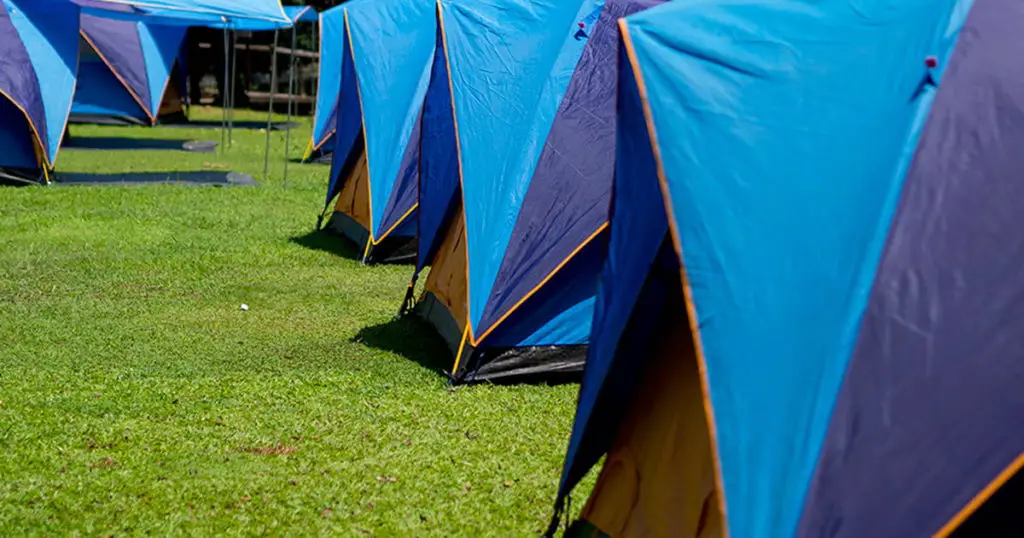
Here are some of the most commonly asked questions about cabin tents:
Are cabin tents difficult to set up?
Not necessarily. Like all tents, it depends on each one individually. They have a lot of fabric to work with thanks to the straight walls, which means it’s usually easier to tackle it with two people.
Can cabin tents withstand windy weather?
Cabin tents are not as good as dome tents for wind proofing, as they are taller. You might find a bit of wobbling going on in very windy conditions. However, if you properly attach it to the ground using the pegs (to drive into the ground) and guy lines (cords that attach your tent to the pegs), you should be able to withstand a bit of windy weather.
If you are interested, you can check out our guide to the best dome tents for more information.
Are cabin tents more expensive than dome tents?
No, not necessarily. Cabin tents vary in price, as do dome tents, so you should be able to find one that suits your budget.
Can I buy a cabin tent second hand?
You can, as people often upgrade their tents depending on their circumstances. It’s always worth looking at it in person first. You’ll have to check the poles and the fabric for any signs of wear and tear, and you’ll need to make sure all the parts are included.
Generally speaking, it’s easier to buy one new, as you won’t have to worry about any unexpected surprises.
Do I need sandbags to weigh down my cabin tent?
No, not necessarily! You can use them if you feel safer, but tents are designed to stay put if attached to the ground according to instructions.
Will I get a warranty with my cabin tent?
Most tents come with some sort of warranty, usually a 1-year limited warranty. This gives you plenty of time to test your tent for manufacturing defects.
Final Thoughts – Which Cabin Tent is Best?
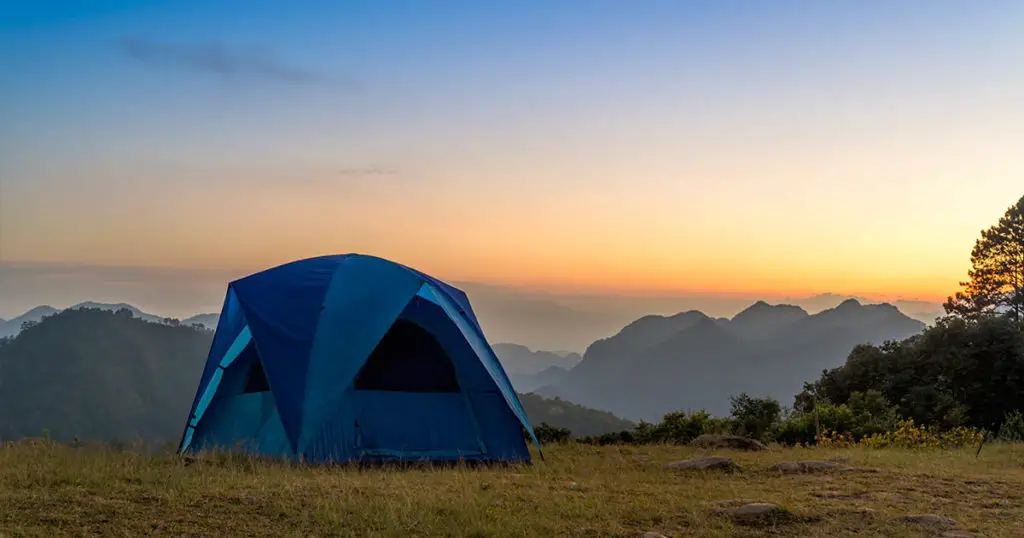
So, to sum up …
We really like the Eureka! Copper Canyon 4-Person Tent. It’s got great weatherproofing, excellent storage, and loads of room. It really feels like a comfortable place to hang out in.
If you’re on a tighter budget though, you could check out the ALPS Mountaineering Camp Creek 4-Person Tent. Or, if you want to focus on the easier set-up, we’d recommend the HIKERGARDEN 6-Person Tent.
If you’ve tried any of these tents, we’d love to hear your thoughts.
We hope this has helped you to find the best cabin tent!
